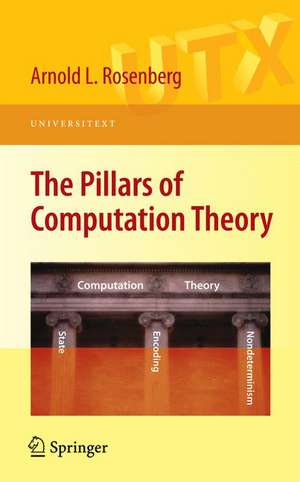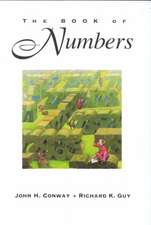The Pillars of Computation Theory: State, Encoding, Nondeterminism: Universitext
Autor Arnold L. Rosenbergen Limba Engleză Paperback – 11 noi 2009
This book is motivated by the belief that a deep understanding of, and operational control over, the few "big" mathematical ideas that underlie Computation Theory is the best way to enable the typical student to assimilate the "big" ideas of Computation Theory into her daily computational life.
Din seria Universitext
- 13%
 Preț: 353.48 lei
Preț: 353.48 lei -
 Preț: 418.67 lei
Preț: 418.67 lei -
 Preț: 465.61 lei
Preț: 465.61 lei -
 Preț: 371.98 lei
Preț: 371.98 lei - 17%
 Preț: 394.41 lei
Preț: 394.41 lei -
 Preț: 356.77 lei
Preț: 356.77 lei - 17%
 Preț: 364.56 lei
Preț: 364.56 lei - 15%
 Preț: 543.75 lei
Preț: 543.75 lei - 15%
 Preț: 497.21 lei
Preț: 497.21 lei -
 Preț: 634.38 lei
Preț: 634.38 lei -
 Preț: 396.53 lei
Preț: 396.53 lei - 17%
 Preț: 427.68 lei
Preț: 427.68 lei - 13%
 Preț: 355.51 lei
Preț: 355.51 lei -
 Preț: 360.07 lei
Preț: 360.07 lei - 17%
 Preț: 365.34 lei
Preț: 365.34 lei -
 Preț: 358.44 lei
Preț: 358.44 lei - 15%
 Preț: 553.33 lei
Preț: 553.33 lei - 17%
 Preț: 364.81 lei
Preț: 364.81 lei -
 Preț: 673.45 lei
Preț: 673.45 lei - 15%
 Preț: 509.58 lei
Preț: 509.58 lei - 17%
 Preț: 427.32 lei
Preț: 427.32 lei - 17%
 Preț: 426.76 lei
Preț: 426.76 lei - 8%
 Preț: 495.43 lei
Preț: 495.43 lei - 20%
 Preț: 569.54 lei
Preț: 569.54 lei - 19%
 Preț: 429.21 lei
Preț: 429.21 lei - 17%
 Preț: 369.06 lei
Preț: 369.06 lei - 15%
 Preț: 737.46 lei
Preț: 737.46 lei - 13%
 Preț: 389.95 lei
Preț: 389.95 lei -
 Preț: 487.96 lei
Preț: 487.96 lei - 20%
 Preț: 628.22 lei
Preț: 628.22 lei -
 Preț: 372.86 lei
Preț: 372.86 lei -
 Preț: 319.07 lei
Preț: 319.07 lei -
 Preț: 379.86 lei
Preț: 379.86 lei -
 Preț: 445.88 lei
Preț: 445.88 lei -
 Preț: 382.36 lei
Preț: 382.36 lei - 15%
 Preț: 533.72 lei
Preț: 533.72 lei - 15%
 Preț: 496.02 lei
Preț: 496.02 lei - 15%
 Preț: 474.82 lei
Preț: 474.82 lei -
 Preț: 389.70 lei
Preț: 389.70 lei -
 Preț: 484.08 lei
Preț: 484.08 lei - 15%
 Preț: 469.41 lei
Preț: 469.41 lei - 15%
 Preț: 643.48 lei
Preț: 643.48 lei -
 Preț: 415.02 lei
Preț: 415.02 lei - 15%
 Preț: 602.25 lei
Preț: 602.25 lei - 20%
 Preț: 510.24 lei
Preț: 510.24 lei - 15%
 Preț: 588.37 lei
Preț: 588.37 lei -
 Preț: 381.59 lei
Preț: 381.59 lei -
 Preț: 489.87 lei
Preț: 489.87 lei -
 Preț: 493.89 lei
Preț: 493.89 lei
Preț: 334.71 lei
Preț vechi: 418.38 lei
-20% Nou
Puncte Express: 502
Preț estimativ în valută:
64.05€ • 67.05$ • 52.99£
64.05€ • 67.05$ • 52.99£
Carte tipărită la comandă
Livrare economică 05-19 aprilie
Preluare comenzi: 021 569.72.76
Specificații
ISBN-13: 9780387096384
ISBN-10: 0387096388
Pagini: 326
Ilustrații: XVIII, 326 p. 49 illus.
Dimensiuni: 155 x 235 x 18 mm
Greutate: 0.48 kg
Ediția:2010
Editura: Springer
Colecția Springer
Seria Universitext
Locul publicării:New York, NY, United States
ISBN-10: 0387096388
Pagini: 326
Ilustrații: XVIII, 326 p. 49 illus.
Dimensiuni: 155 x 235 x 18 mm
Greutate: 0.48 kg
Ediția:2010
Editura: Springer
Colecția Springer
Seria Universitext
Locul publicării:New York, NY, United States
Public țintă
GraduateCuprins
PROLEGOMENA.- Mathematical Preliminaries.- STATE.- Online Automata: Exemplars of #x201C;State#x201D;.- Finite Automata and Regular Languages.- Applications of the Myhill#x2013;Nerode Theorem.- Enrichment Topics.- ENCODING.- Countability and Uncountability: The Precursors of #x201C;Encoding#x201D;.- Enrichment Topic: #x201C;Efficient#x201D; Pairing Functions, with Applications.- Computability Theory.- NONDETERMINISM.- Nondeterministic Online Automata.- Nondeterministic FAs.- Nondeterminism in Computability Theory.- Complexity Theory.
Recenzii
From the reviews:
“Rosenberg (Colorado State) charts another path by teaching the major themes that underlie all of computer science. He identifies three themes, or pillars: ‘state,’ ‘encoding,’ and ‘nondeterminism.’ … This work is helpful for mathematically prepared undergraduates … . Summing Up: Recommended. Upper-division undergraduates, graduate students, researchers, and faculty.” (P. Cull, Choice, Vol. 47 (9), May, 2010)
“The author’s intentions are clear from the very beginning: he wants to change the way computation theory is taught to undergraduates. … The intended audience includes advanced undergraduates and beginning graduate students. … student whose interests run to theoretical computer science, this would be a challenging and attractive book. … For more typical students there are no exercises directly tied to the immediate text and few anywhere that are more routine – the kind of many students need to ground themselves in the subject.” (William J. Satzer, The Mathematical Association of America, March, 2010)
“This authoritative, tightly woven book is unsurpassed as the definitive computation theory text and reference … it has my highest recommendation.” (George Hacken, ACM Computing Reviews, August, 2010)
“Rosenberg (Colorado State) charts another path by teaching the major themes that underlie all of computer science. He identifies three themes, or pillars: ‘state,’ ‘encoding,’ and ‘nondeterminism.’ … This work is helpful for mathematically prepared undergraduates … . Summing Up: Recommended. Upper-division undergraduates, graduate students, researchers, and faculty.” (P. Cull, Choice, Vol. 47 (9), May, 2010)
“The author’s intentions are clear from the very beginning: he wants to change the way computation theory is taught to undergraduates. … The intended audience includes advanced undergraduates and beginning graduate students. … student whose interests run to theoretical computer science, this would be a challenging and attractive book. … For more typical students there are no exercises directly tied to the immediate text and few anywhere that are more routine – the kind of many students need to ground themselves in the subject.” (William J. Satzer, The Mathematical Association of America, March, 2010)
“This authoritative, tightly woven book is unsurpassed as the definitive computation theory text and reference … it has my highest recommendation.” (George Hacken, ACM Computing Reviews, August, 2010)
Textul de pe ultima copertă
Computation theory is a discipline that strives to use mathematical tools and concepts in order to expose the nature of the activity that we call “computation” and to explain a broad range of observed computational phenomena. Why is it harder to perform some computations than others? Are the differences in difficulty that we observe inherent, or are they artifacts of the way we try to perform the computations? Even more basically: how does one reason about such questions?
This book strives to endow upper-level undergraduate students and lower-level graduate students with the conceptual and manipulative tools necessary to make Computation theory part of their professional lives. The author tries to achieve this goal via three stratagems that set this book apart from most other texts on the subject.
(1) The author develops the necessary mathematical concepts and tools from their simplest instances, so that the student has the opportunity to gain operational control over the necessary mathematics.
(2) He organizes the development of the theory around the three “pillars” that give the book its name, so that the student sees computational topics that have the same intellectual origins developed in physical proximity to one another.
(3) He strives to illustrate the “big ideas” that computation theory is built upon with applications of these ideas within “practical” domains that the students have seen elsewhere in their courses, in mathematics, in computer science, and in computer engineering.
This book strives to endow upper-level undergraduate students and lower-level graduate students with the conceptual and manipulative tools necessary to make Computation theory part of their professional lives. The author tries to achieve this goal via three stratagems that set this book apart from most other texts on the subject.
(1) The author develops the necessary mathematical concepts and tools from their simplest instances, so that the student has the opportunity to gain operational control over the necessary mathematics.
(2) He organizes the development of the theory around the three “pillars” that give the book its name, so that the student sees computational topics that have the same intellectual origins developed in physical proximity to one another.
(3) He strives to illustrate the “big ideas” that computation theory is built upon with applications of these ideas within “practical” domains that the students have seen elsewhere in their courses, in mathematics, in computer science, and in computer engineering.
Caracteristici
Large selection of exercises Presents a unique approach to computation theory Includes supplementary material: sn.pub/extras















